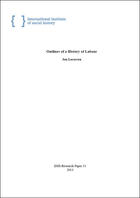
The scope of contemporary labour history research has broadened considerably, with regard to time frames and geographic space. This overview article provides insights about what we can learn from the new global labour history, using important new research findings to illustrate the ideas. A definition of work is provided and, after a survey of the origins of six main types of labour relations, the question is discussed of why and how major shifts in labour relations occurred in world history. Recent research indicates that the classical schemas used to understand the course of world history (such as those of Adam Smith, Karl Marx and Max Weber) as well some of their critics (like Karl Polanyi and Alexander Chayanov) contradict the historical facts. Those basically teleological schemas ought therefore to be revised.
The article concludes with a discussion of three important global turning points in contemporary labour relations, which confirm our ignorantia about the movements of history. To provide better knowledge about long-run historical trends in working life, and to write the global history of labour, it is argued, much more empirical and comparative research about the world’s working population is possible and necessary.
Table of Contents
- The meaning of “work” and “labour”
- The emergence of labour relations
- Long-term shifts in labour relations
- How do shifts in labour relations occur?
- Why do labour relations change?
- Recent developments
- Conclusion
- Appendix: Grain wages (litres per day) for unskilled workers in the Middle East
- and the Eastern Mediterranean seaboard in the very long term
- Bibliography
(Ook verschenen in het Nederlands onder de titel: Een geschiedenis van de arbeid in grote lijnen)
